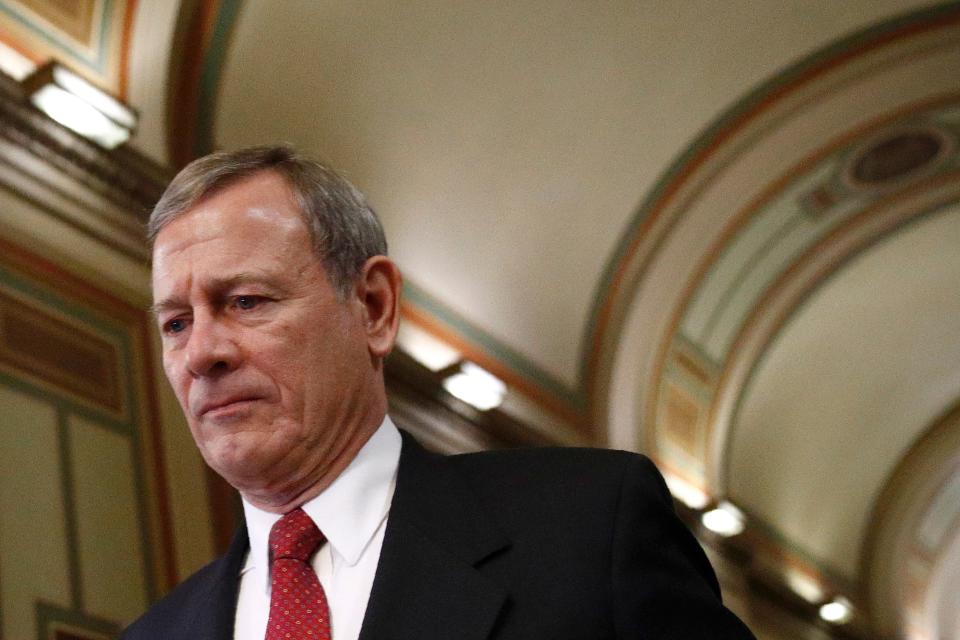Report: Roberts tried to persuade rest of Supreme Court to keep Roe v. Wade in place
- Oops!Something went wrong.Please try again later.
- Oops!Something went wrong.Please try again later.
WASHINGTON – One of the more interesting power dynamics from the Supreme Court's historic term that ended in June was the sidelining of Chief Justice John Roberts in one of the most important outcomes in years: the decision to overturn Roe v. Wade.
Roberts signaled during oral arguments in December that he wasn't keen to knock down the 1973 precedent that established a constitutional right to abortion. He reiterated the point in a concurrence when the ruling landed in June. Roberts supported upholding Mississippi's ban on most abortions after 15 weeks of pregnancy, but did not see the need to target Roe.
The internal dynamics were reinforced by CNN reporting Tuesday. Citing unnamed sources, the network reported Roberts had tried to convince his colleagues to join his more limited approach to the abortion decision – and failed. The report raises the prospect that the dramatic leak of a draft opinion weeks earlier didn't help Roberts' effort.
The chief: Roberts wanted to go slow ending Roe. His colleagues were in a hurry.
Grip: Roberts facing test of leadership amid tense time at Supreme Court
Here's what we know about Roberts' role in the abortion case.
Who is Chief Justice John Roberts?
John Roberts is the 17th chief justice of the United States. A former federal appeals court judge, he was nominated to the Supreme Court by President George W. Bush in 2005 and confirmed by the Senate later that year on a 78-22 vote.
Bio: What to know about John Roberts, chief justice of the United States
Overall, Roberts and Associate Justice Brett Kavanaugh remain in the ideological center of the court. Both justices were in the majority in 95% of the court's decisions in the term that ended in June, according to statistics compiled by SCOTUSblog.
Why did some think Roberts could save Roe?
Roberts has demonstrated an ability to build majorities around narrow rulings in the past – the kind of incremental outcomes that left neither liberals nor conservatives particularly happy when the court wrapped each term. Often viewed as supporting incremental outcomes, Roberts is especially worried about the high court's reputation if the public views its rulings as being driven by politics.
Soft power: How Chief Justice John Roberts is exerting influence
What did Roberts say about Roe?
In the Mississippi case, Roberts didn't join the majority to overturn Roe. Instead, he articulated what some saw as the centrist's position: He wanted to uphold the Mississippi ban on most abortions after 15 weeks of pregnancy at issue in the case, but not overrule one of the Supreme Court's best recognized precedents.
Upholding the Mississippi law, he wrote, is as far as he would have gone "out of adherence to a simple yet fundamental principle of judicial restraint: If it is not necessary to decide more to dispose of a case, then it is necessary not to decide more."
In the end, no other justice joined that view.
The vote to overturn Roe was 5-4. The vote to uphold Mississippi's ban was 6-3.
"To write alone is truly kind of interesting as the chief," Glenn Cohen, a professor and deputy dean at Harvard Law School told USA TODAY in June. "One feels a little bit that this is his moment of shouting into the desert as a judicial minimalist."
Associate Justice Samuel Alito, writing for the majority in the abortion case, countered that Roberts' approach would have simply kept the controversy alive, prompting similar appeals over 14-week bans, 12-week bans and so on.

Did Roberts lobby colleagues behind the scenes?
In the cloistered halls of the Supreme Court, it's often difficult to determine what's happening behind the scenes between the nine justices. But it is generally the case that the justices try to convince each other of their positions – sometimes in personal meetings and sometimes through the distribution of draft opinions.
Whodunit: Answers scarce on who leaked draft Supreme Court abortion opinion
A report in CNN on Tuesday, citing unnamed sources, suggested Roberts was leaning on his conservative colleagues right up until the court handed down its decision June 24. In May, in the middle of that effort, an early draft of the opinion was leaked. The unprecedented disclosure, many have speculated, might have made it harder for any justice to switch their vote if it appeared that they were caving to the backlash the draft opinion prompted from abortion rights supporters.
"Leaking this early draft makes that more costly for a defector because now people will think that they changed their vote after the leak," Kermit Roosevelt, a professor at the University of Pennsylvania Carey Law School, had speculated to USA TODAY in an interview this year.
This article originally appeared on USA TODAY: John Roberts tried to convince SCOTUS justices to keep Roe: report

